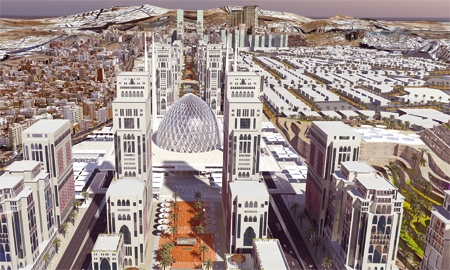
Makkah, the land of revelation and the place dearest to the hearts of Muslims around the world, has always enjoyed special attention from the rulers of this blessed land. Numerous expansion and development projects were completed to facilitate the performance of ritual for the visitors to the Holy Mosque. One of the largest and latest development projects under construction is the King Abdul Aziz Road project, which is expected to be completed in 2012.
The 12 billion riyal (£2.12 billion) King Abdul Aziz Road project is the nucleus of a larger project to develop the unplanned neighbourhoods in Makkah. Resolution of the issues concerning these neighbourhoods have special attention due to humanitarian, health, social, economical, environmental and security implications.
Movement and transportation within Makkah with its unique topography of mountains and valleys is key to the planning process, therefore, the King Abdul Aziz Road project plays a crucial role in the future development of Makkah. The importance of this road is further accentuated due to the fact that it will become the western gate of Makkah and a main path for visitors to the Holy Mosque.
Umm Al Qura for Development and Construction Company was honoured with the assignment of implementing the King Abdul Aziz Road project by the Custodian of the Two Holy Mosques and under the guidance and vision of Prince Khaled Al Faisal the Governor of Makkah.
This project emphasises the role of private sector as a partner with the government in implementing development projects. This reflects the government’s interest in promoting and raising the efficiency of the services provided in a city as important as Makkah.
Also, this project is a direct support to the achievement of strategic, structural, environmental and investment objectives in the region, as it provides the main entrance to the holy city of Makkah from the west and a path for pedestrians and motor vehicles to and from the Holy Mosque with a prestigious urban development on both sides of the road. In addition, the project will support the government’s plans in resolving undeveloped settlements in the project area.
Urban development
Leaders of Saudi Arabia have spared no effort in working to develop the land of the Two Holy Mosques in Makkah and Madinah and serve pilgrims and Umrah visitors from across the globe throughout the year.
To achieve this, the government implemented the largest expansion projects in the history of the Two Holy Mosques. It has designed ambitious developments aiming to enhance Makkah Al-Mukarramah and to find a practical solution to the surrounding densely populated slums. These areas lack the most basic necessities of modern life and surround the central area of the city from several points and thus hinder the implementation of any comprehensive development.
| No effort has been spared in the redevelopment of Makkah and Madinah, with the creation of the largest expansion initiatives in the country’s history, which include the massive King Abdul Aziz Road regeneration and modernisation project |
Meeting the city’s needs now and in the future
The KAAR project is designed to meet transportation needs now, and in the future. It will provide transportation means to accommodate the growing population and ever changing living conditions. The project involves the provision of a light rail system capable of transporting 40,000 people per hour from the western end of KAAR to Al-Haram in just a few minutes. It is considered the most sustainable means of transportation due to its low levels of pollution emissions. The light rail is linked to the Al-Haramain railway station (the express train project connecting Makkah with Madinah) at the southern western edge of the project.
The KAAR project is diverse, comprising residential units (hotels and apartments) alongside commercial and recreational areas. The expected capacity of the project is approximately 197,000 residents and 28,000 prestigious hotel rooms. The project will provide permanent housing units of 7,600 with varied areas, thus addressing the lack of housing for residents of the holy city of Makkah. Libraries, medical and shopping centres, mosques, public utilities, governmental offices, and educational institutions are also included in the general vision of the project.
To ensure higher levels of security and safety for residents, the project will include a network of control centres connected to the control centre of Jabal Omar project, with a particular aim of managing pedestrian movement around Al-Haram.
The project meets recently implemented design criteria with respect to buildings’ elevations and physical structures that ensure they are in harmony with the urban community, providing calm and comfortable surroundings for residents.
The architecture is designed to follow local Islamic styles, reflecting the spiritual sense of the holy city of Makkah.
King Abdullah Mosque, with its spacious areas and yards, is located at the midpoint of the project. This central position, with its close proximity to pedestrian pathways, will help worshippers perform their prayers in this mosque as an alternative to the congregation prayer at Al-Haram.
The total area of the mosque covers approximately 124,000m2. Following a unique design structure containing a marvellous dome on a square platform with a capacity to accommodate 40,000 worshippers, the design encompasses multiple services under one roof. The basement contains a state-of-the-art multi-media transmission station, large parking area, cultural centre, ablution area, and public utilities that serve large volume of visitors and Hajj performers.
The building reflects a unique style of innovative architecture, with its standard dimensions and invisible pillars of beams. The distinguished minaret and significant dome will be constructed from an innovative blend of stone and metal structures, ensuring the building is an impressive edifice that will be admired by all.
Coming closer to the Holy Mosque
Visitors staying at one of the many affordable residential units can walk their way to the Holy Mosque down the spacious pedestrian pathway, use the modern transportation rail system or drive their own cars. Ahead they will see, even from a faraway distance, the grand Jabal Omar project, a majestic structure overlooking Al-Haram from its prime location.
0 COMMENTS